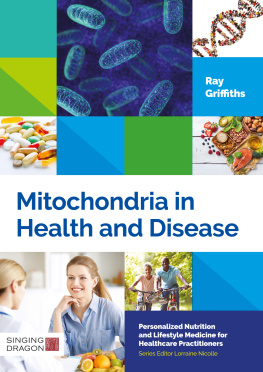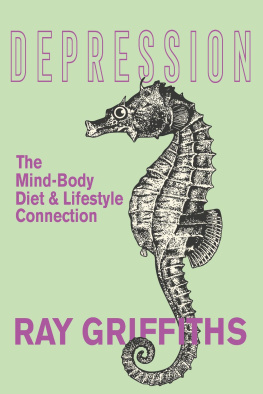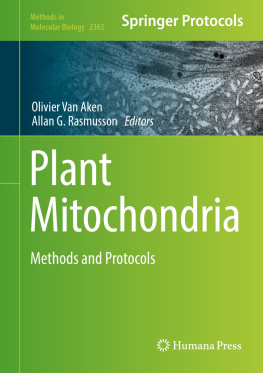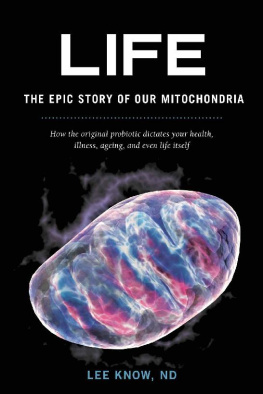
Mitochondria in
Health and Disease
Part of
Personalized Nutrition and Lifestyle
Medicine for Healthcare Practitioners series
Ray Griffiths
Foreword by Lorraine Nicolle

Contents
Foreword
Welcome to the first of a new series of books on Personalized Nutrition and Lifestyle Medicine. Written and edited by healthcare practitioners, for practitioners, this series aims to help facilitate new levels of success with individuals striving for optimal health and peak performance.
Were all well aware that chronic illness is far too prevalent and its consequences too severe for patients, their families and communities, for over-burdened healthcare systems and even for nations financial resources and GDP. Our seeming inability to slow the march of chronic disease may even be threatening the health of future generations.
But there is hope on the horizon, with the growing recognition that ageing populations could be far more healthy, happy and active if we were brave enough to start redirecting resources away from drug-based interventions that aim to suppress symptoms, towards more personalized, lifestyle-based healthcare approaches.
Such systems biology approaches include Functional Medicine, Ecological Medicine and Clinical Psychoneuroimmunology, to name but a few. They strive to identify and tackle the underlying causes of an individuals ill-health. They focus on providing bespoke interventions, tailored to the unique set of biochemical needs of the patient, and which are based first and foremost on nutrition and lifestyle changes.
Nutrition and lifestyle are our most powerful tools because they are epigenetic inputs they alter the behaviour of our genes, which in turn sets us on particular trajectories of health and disease.
This first book of the series focuses on the role of the powerhouses of our cells the mitochondria and how their functioning affects not only our ability to produce energy, but a great many other aspects of our health. Many of todays most common diseases, including diabetes, cardiovascular disease, cancer and dementia, are driven in part by mitochondrial function going awry. So for anyone striving for optimal health, it makes sense to assess mitochondrial function and provide targeted support where necessary.
The author Ray Griffiths is passionate about the workings of these tiny organelles. He has scoured more than 1500 scientific papers to compile this repository of information on the various tasks that mitochondria do for us, why and how they can go wrong, what happens when they do, and what practitioners can do to identify such dysfunction and intervene in a way that improves health and longevity.
You might notice some recurring themes throughout this text and the books that follow. Such themes represent real progression in healthcare thinking. They include:
That the supreme governor of our health is not what genes we have inherited, but the behaviour of those genes. In turn, this is altered by lifestyle, especially by what we eat, how much we eat and the timing of our food intake.
That this misbehaviour of our genes disrupts the function of various body systems; and that most degenerative disease is preceded by years of such systems malfunction.
That all body systems are connected, such that dysfunction in one biological process can have far-reaching effects on other body systems.
That different biological systems may be impaired in different individuals with the same disease, and that consequently people with exactly the same symptoms may require very different interventions.
That some individuals may need certain nutrients at far higher levels than the standard recommended intakes, in order to achieve normal functioning. Getting anything less may cause cells to accumulate damage insidiously throughout the years and eventually trigger chronic illness.
That far from comprising merely human cells, it turns out that were human-microbe hybrids. The activity of the microbes we carry impacts our health perhaps just as much as do our own cellular functions. And, guess what? Our microbial balance is significantly determined by what we eat.
That human health requires balance: between the various body system functions and between different environmental inputs. An example in this book is the power of hormesis: timely and appropriate stressors (like metabolic switching/ketogenesis and/or the use of toxic phytochemicals) produce counteractive, health-promoting responses like detoxification, antioxidant activity and the renewal of cell and organelle populations. (Many pharmaceuticals create imbalance otherwise known as side-effects.)
That the evidence on which we rely should encompass far more than simply randomized controlled trials. Such studies are designed to minimize variation across groups of participants. In contrast, personalised approaches in healthcare require individual variation to be embraced (n = 1). Advances in nutrigenomics, informatics and wearable technologies will significantly strengthen this new evidence base.
This book is for everyone who is excited by developments like these and is keen to explore how they can be applied to real-world situations in order to make things better: to reduce the risk of chronic illness, to improve outcomes for people living with seemingly entrenched diseases, to age better and to reach peak levels of physical and mental performance.
Lorraine Nicolle MSc, MBANT, CNHC Series Editor
www.LorraineNicolleNutrition.co.uk
Such an approach does not reject the use of pharmaceuticals but considers their use should be a last resort, rather than an initial intervention. This is different to situations of acute care, where drugs and/or surgery may be more appropriate as a first option.
Disclaimer
The information contained in this book is for the explicit use of appropriately trained healthcare practitioners. Only healthcare practitioners are qualified to integrate information from client histories and laboratory results. In this way, healthcare practitioners are able to produce nutritional guidance tailored to an individuals unique biochemistry.
Part II contains information relating to mitochondrial involvement in many complex health conditions. The author is in no way claiming that using this information for an intervention will resolve these conditions. The information is more a thought-provoking exercise, to enable a practitioner to explore other avenues when working with complex patients.
In accordance with the act, , Cancer, is designed to help inform a healthcare practitioner about cancer prevention strategies and palliative care only as a complement to primary medical care.
Abbreviations
ABC ATP-binding cassette
ACE angiotensin-converting enzyme
ADP adenosine diphosphate
AGE advanced glycation end-products
AMP adenosine monophosphate
AMPK AMP-activated protein kinase
ARE antioxidant response element
ATP adenosine triphosphate
BMI body mass index
CFS chronic fatigue syndrome
CIC citrate carrier
CJD Creutzfeldt-Jakob disease (mad cow disease)
CLA conjugated linoleic acid
CNS central nervous system
CoA coenzyme A
CoQ10 coenzyme Q10
DAMP damage-associated molecular pattern
DHA docosahexaenoic acid
DII dietary inflammatory index
DNA deoxyribonucleic acid
EGCG epigallocatechin-3-gallate
eNOS endothelial nitric oxide synthase
EPA eicosapentaenoic acid
ER endoplasmic reticulum
Next page













